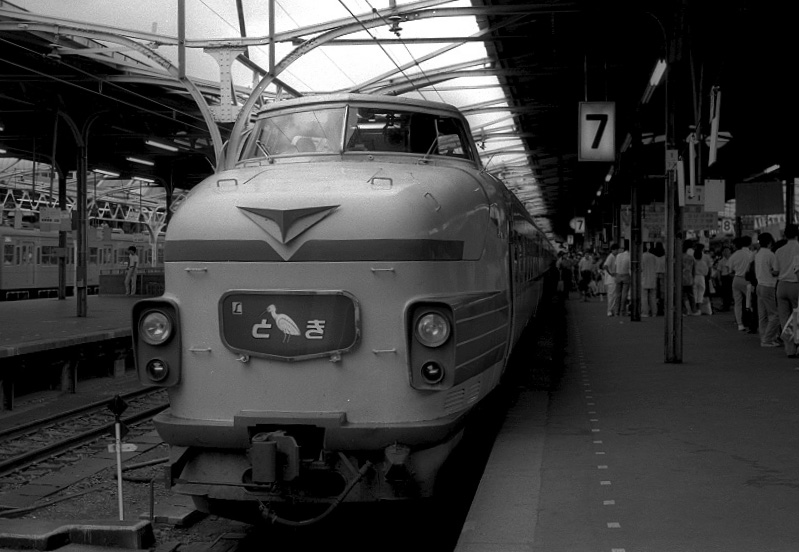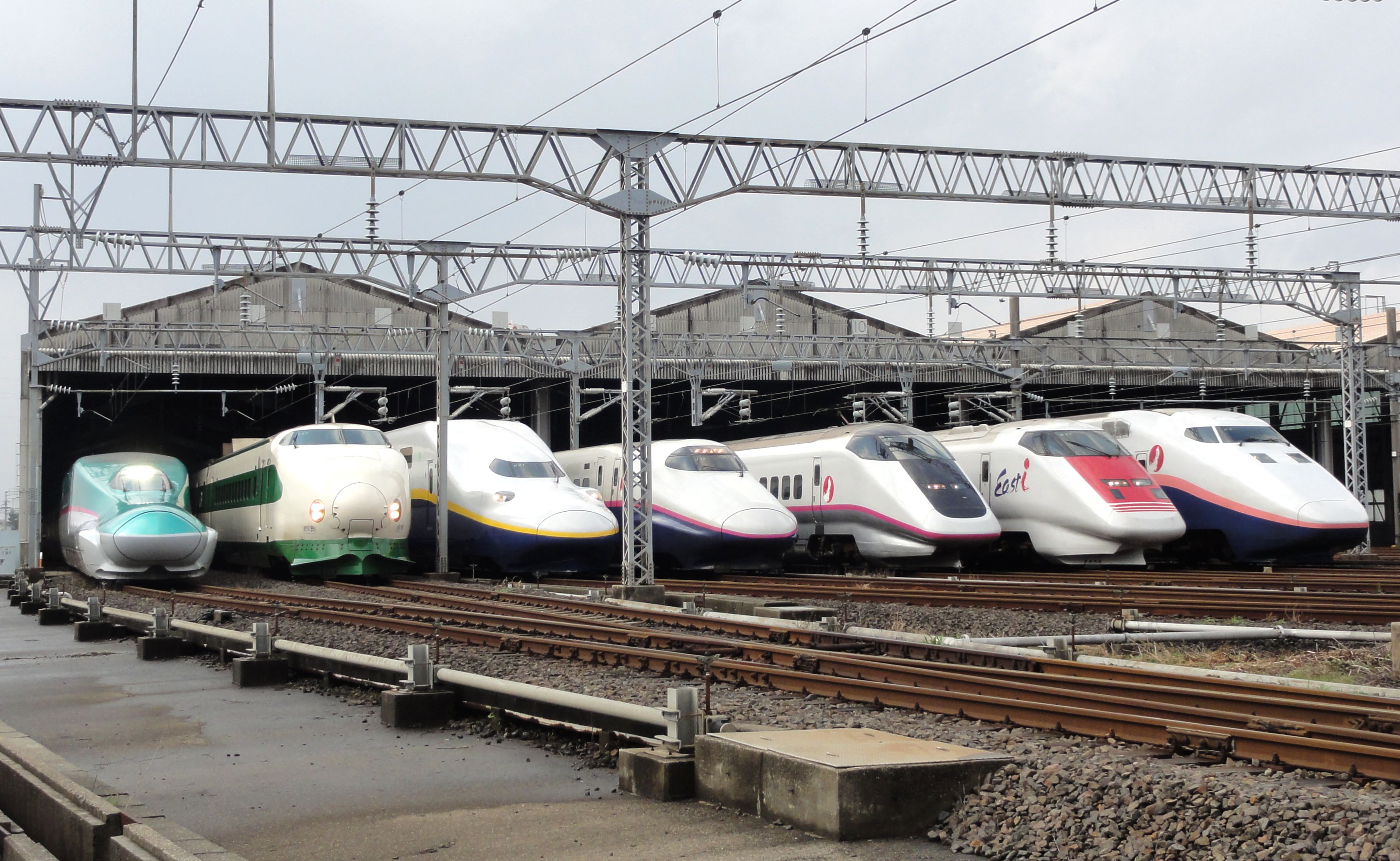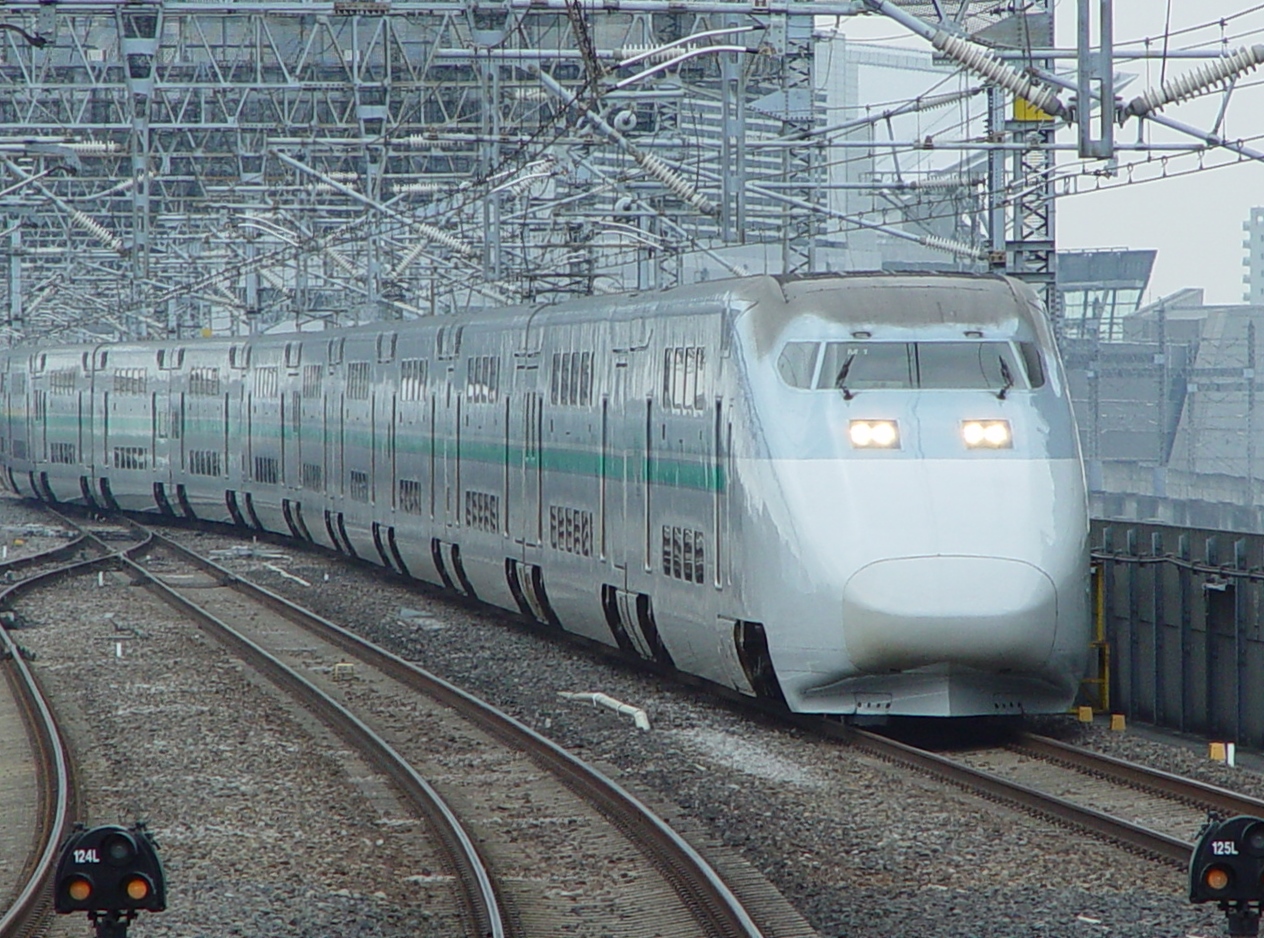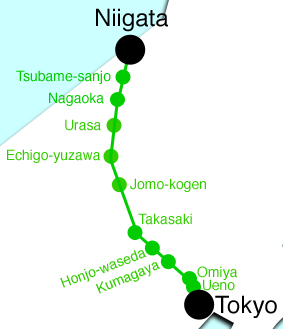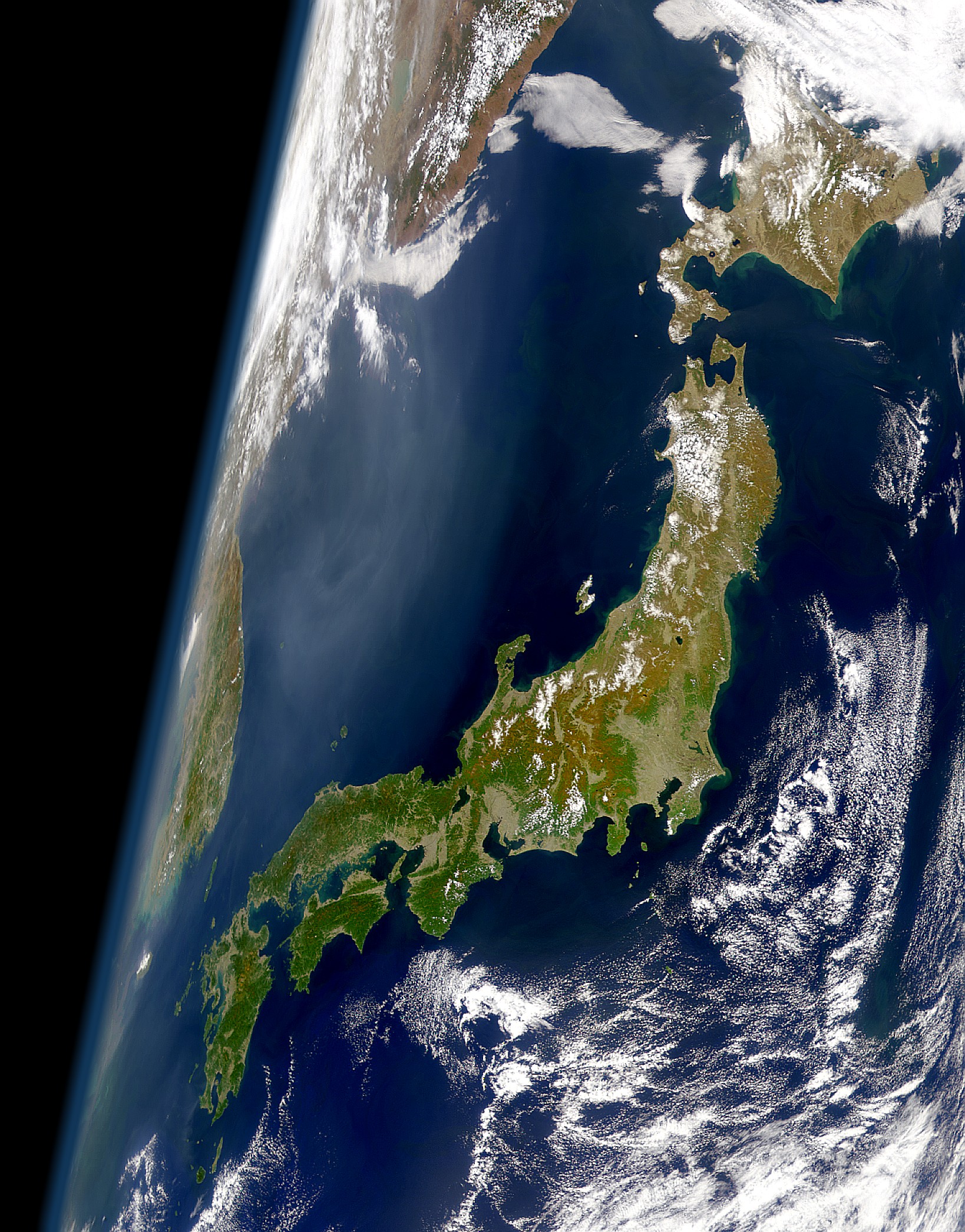|
Toki (train)
The is a high-speed Shinkansen train service operated by East Japan Railway Company (JR East) on the Joetsu Shinkansen in Japan. The name is taken from the Japanese name of the crested ibis, for which Niigata is famous. Station Stops * * * * * * * * * * * * * * * * * * * * * (*) Not served by all trains Rolling stock * E2 series 10-car sets (from 26 January 2013) * E7 series 12-car sets (''Toki'') (from 3 March 2019) File:E2 J63 omiya.JPG, An E2 series set File:Series-E7-F21.jpg, An E7 series set Former rolling stock * E1 series 12-car sets (''Max Toki'') (until 28 September 2012) * 200 series 10-car sets "K" sets (until 15 March 2013) * E4 series 8-car sets (''Max Toki'') (until 1 October 2021) File:JR East Shinkansen E1(renewal).jpg, A refurbished E1 series set File:JNR200-K51.jpg, A refurbished 200 series set File:Series-E4-P20.jpg, A refurbished E4 series set History Limited express The name ''Toki'' was first introduced on 10 June 1962 for limited expr ... [...More Info...] [...Related Items...] OR: [Wikipedia] [Google] [Baidu] |
Shinkansen
The , colloquially known in English as the bullet train, is a network of high-speed railway lines in Japan. Initially, it was built to connect distant Japanese regions with Tokyo, the capital, to aid economic growth and development. Beyond long-distance travel, some sections around the largest metropolitan areas are used as a commuter rail network. It is operated by five Japan Railways Group companies. Over the Shinkansen's 50-plus-year history, carrying over 10 billion passengers, there has been not a single passenger fatality or injury on board due to derailments or collisions. Starting with the Tokaido Shinkansen () in 1964, the network has expanded to currently consist of of lines with maximum speeds of , of Mini-Shinkansen lines with a maximum speed of , and of spur lines with Shinkansen services. The network presently links most major cities on the islands of Honshu and Kyushu, and Hakodate on northern island of Hokkaido, with an extension to Sapporo under cons ... [...More Info...] [...Related Items...] OR: [Wikipedia] [Google] [Baidu] |
Limited Express
A limited express is a type of express train service. It refers to an express service that stops at a limited number of stops in comparison to other express services on the same or similar routes. Japan The term "limited express" is a common translation of the Japanese compound noun ; literally "special express"; often abbreviated as . Although some operators translate the word differently, this section is about ''tokubetsu kyūkō'' trains in Japan regardless of the translation by the operators. This term also includes terms with ''limited express'' in them, such as . There are two types of limited express trains: intercity and commuter. The former type of limited express trains generally use long-distance coaches, equipped better than other ordinary express trains, including reserved seating, dining cars or food and beverage carts, and "green cars" (first class cars). The latter type of limited express train usually incurs no surcharge, but seating is usually first-come, ... [...More Info...] [...Related Items...] OR: [Wikipedia] [Google] [Baidu] |
List Of Named Passenger Trains Of Japan ...
This article contains lists of named passenger trains in Japan. Shinkansen (bullet trains) Daytime trains Limited express (partial list) Express Rapid Night trains Limited express Express Rapid See also * Rail transport in Japan References * JR Timetable, December 2008 * * {{reflist List of named passenger trains of Japan Japan Named passenger trains Luxury trains are a premium travel option designed to offer a comfortable ride and evoke an association with history and heritage. Some luxury trains promote tourism in destinations across a region, while others (such as the Maharajas' Express) ... [...More Info...] [...Related Items...] OR: [Wikipedia] [Google] [Baidu] |
Asahi (train)
The was a limited-stop train service that operated until November 2002 in Japan on the Joetsu Shinkansen high-speed line between Tokyo and Niigata. Operations The ''Asahi'' shinkansen services ran approximately hourly, with two down services (''Asahi'' 1 and 3) permitted to operate at 275 km/h in the tunnel section between and using specially modified 200 series (F90) sets, completing the journey in 1 hour 40 minutes (compared to the fastest journey time of 1 hour 37 minutes in 2008 for '' Toki'' services operating at a maximum speed of 240 km/h).JR Timetable, December 2008 Rolling stock * 200 series 10/12-car sets (November 1982 – November 2002) * E1 series 12-car sets, as ''Max Asahi'' (July 1994 – November 2002) * E2 series 8-car sets (December 1998 – November 2002) * E4 series 8-car sets, as ''Max Asahi'' (May 2001 – November 2002) History The name ''Asahi'', meaning "morning sun" in Japanese, dates from before World War II, when i ... [...More Info...] [...Related Items...] OR: [Wikipedia] [Google] [Baidu] |
Echigo-Yuzawa Station
is a railway station operated by East Japan Railway Company (JR East), located in the resort town of Yuzawa in Niigata Prefecture, Japan. The station is located from . Lines Echigo-Yuzawa Station is serviced by the following lines: * JR East ** Joetsu Shinkansen ** Joetsu Line * Hokuetsu Express ** Hokuhoku Line Station layout The station has two ground-level island platforms and one side platform for normal trains and two elevated island platforms for the Joetsu Shinkansen. The station building is located above the local platforms and underneath the Shinkansen platforms. The station has a ''Midori no Madoguchi'' staffed ticket office. Facilities at the station include souvenir shopping and eating facilities, as well as a sake-themed attraction complete with an indoor ''onsen'' bath. Platforms History The station opened on 1 November 1925. With the privatization of Japanese National Railways (JNR) on 1 April 1987, the station came under the control of JR East. Th ... [...More Info...] [...Related Items...] OR: [Wikipedia] [Google] [Baidu] |
Tanigawa (train)
The is a high-speed train service operated by the East Japan Railway Company (JR East) on the in Japan. Rolling stock * E2 series 10-car sets (from 26 January 2013) * E7 series (from 3 March 2019) File:E2 J8 Nasuno 272 Omiya 20110206.jpg, E2 series shinkansen train File:Series-E7-F21.jpg, An E7 series shinkansen train Former rolling stock * 185 series EMUs (15 November 1982 - September 1997) * E1 series (''Max Tanigawa'') (until September 2012) * 200 series 10-car "K" sets (1 October 1997 – 15 March 2013) * E4 series (''Max Tanigawa'') (until 1 October 2021) File:JR East 185 shintokyu tanigawa akagi.jpg, ''Tanigawa'' limited express service operated by 185 series EMUs in the 1980s File:F8 Tanigawa 79 Gala-Yuzawa 20060115.JPG, 200 series shinkansen train on ''Tanigawa'' service near Gala-Yuzawa Station File:E1inTakasaki.JPG, E1 series at Takasaki Station File:E4inKumagayaSt1.JPG, E4 series in January 2007 History The name ''Tanigawa'' (written as "谷川") was fir ... [...More Info...] [...Related Items...] OR: [Wikipedia] [Google] [Baidu] |
Jōetsu Shinkansen
The is a high-speed shinkansen railway line connecting Tokyo and Niigata, Japan, via the Tōhoku Shinkansen, operated by the East Japan Railway Company (JR East). Despite its name, the line does not pass through the city of Joetsu or the historical Jōetsu region, which instead are served by the Hokuriku Shinkansen. The name instead originates from the parallel Jōetsu Line, which in turn is named after the two provinces that it connects: Jōshū (an alternate name for Kōzuke Province which comprises today's Gunma Prefecture), and Echigo Province (modern day Niigata Prefecture). Train services * '' Toki'', Tokyo - Niigata (limited-stop) * '' Tanigawa'', Tokyo - Echigo-Yuzawa (all-stations, since October 1997) Discontinued services * '' Asahi'', Tokyo - Niigata (discontinued December 2002) * '' Max Asahi'', Tokyo - Niigata (discontinued December 2002) * '' Max Toki'', Tokyo - Niigata (discontinued October 2021) * '' Max Tanigawa'', Tokyo - Echigo-Yuzawa (discontinued Octobe ... [...More Info...] [...Related Items...] OR: [Wikipedia] [Google] [Baidu] |
Niigata Station
is a major railway station in Chūō-ku, Niigata, Japan, operated by East Japan Railway Company (JR East). The station is at the centre of Niigata city, the largest city on the Sea of Japan coast in Honshu. It forms the central station for the railway infrastructure along the Sea of Japan coast, and is also the terminus of the Jōetsu Shinkansen high-speed line from Tokyo. Lines Niigata Station is served by the following lines. * Joetsu Shinkansen * Shin'etsu Main Line * Hakushin Line * Echigo Line Station layout The station has two side platforms (former 1, 4) and two island platforms (former 2/3, and 8/9) at ground level serving a total of six tracks for conventional narrow gauge lines, of which only one island platform remains in use for trains originating from Niigata Station. This island platform (8/9) is an extension of one of the side platforms (1). The station also has two elevated side platforms 2, 5) and one island platform 3,4) serving conventional narrow gauge lin ... [...More Info...] [...Related Items...] OR: [Wikipedia] [Google] [Baidu] |
Ueno Station
is a major railway station in Tokyo's Taitō ward. It is the station used to reach the Ueno district and Ueno Park—which contains Tokyo National Museum, The National Museum of Western Art, Ueno Zoo, Tokyo University of the Arts and other famous cultural facilities. A major commuter hub, it is also the traditional terminus for long-distance trains from northern Japan, although with the extension of the Shinkansen lines to Tokyo Station this role has diminished in recent years. A similar extension of conventional lines extended Takasaki Line, Utsunomiya Line and Joban Line services to Tokyo Station via the Ueno-Tokyo Line in March 2015, using existing little-used tracks and a new viaduct; the Ueno-Tokyo Line connects these lines with the Tokaido Main Line, allowing through services to Shinagawa, Yokohama, Odawara and Atami stations. Ueno Station is close to Keisei Ueno Station, the Tokyo terminus of the Keisei Main Line to Narita Airport Station. Lines This stat ... [...More Info...] [...Related Items...] OR: [Wikipedia] [Google] [Baidu] |
JNR 181 Series Kuha 180 Toki At Ueno Station
The abbreviated JNR or , was the business entity that operated Japan's national railway network from 1949 to 1987. Network Railways As of June 1, 1949, the date of establishment of JNR, it operated of narrow gauge () railways in all 46 prefectures of Japan. This figure expanded to in 1981 (excluding Shinkansen), but later reduced to as of March 31, 1987, the last day of JNR. JNR operated both passenger and freight services. Shinkansen Shinkansen, the world's first high-speed railway was debuted by JNR in 1964. By the end of JNR in 1987, four lines were constructed: ; Tōkaidō Shinkansen: , completed in 1964 ; Sanyō Shinkansen: , completed in 1975 ; Tōhoku Shinkansen: , as of 1987 ; Jōetsu Shinkansen: , completed in 1982 Buses JNR operated bus lines as feeders, supplements or substitutions of railways. Unlike railway operation, JNR Bus was not superior to other local bus operators. The JR Bus companies are the successors of the bus operation of JNR. Ships JNR op ... [...More Info...] [...Related Items...] OR: [Wikipedia] [Google] [Baidu] |
Honshu
, historically called , is the largest and most populous island of Japan. It is located south of Hokkaidō across the Tsugaru Strait, north of Shikoku across the Inland Sea, and northeast of Kyūshū across the Kanmon Straits. The island separates the Sea of Japan, which lies to its north and west, from the North Pacific Ocean to the south and east. It is the seventh-largest island in the world, and the second-most populous after the Indonesian island of Java. Honshu had a population of 104 million , constituting 81.3% of the entire population of Japan, and is mostly concentrated in the coastal areas and plains. Approximately 30% of the total population resides in the Greater Tokyo Area on the Kantō Plain. As the historical center of Japanese cultural and political power, the island includes several past Japanese capitals, including Kyōto, Nara and Kamakura. Much of the island's southern shore forms part of the Taiheiyō Belt, a megalopolis that spans several o ... [...More Info...] [...Related Items...] OR: [Wikipedia] [Google] [Baidu] |
